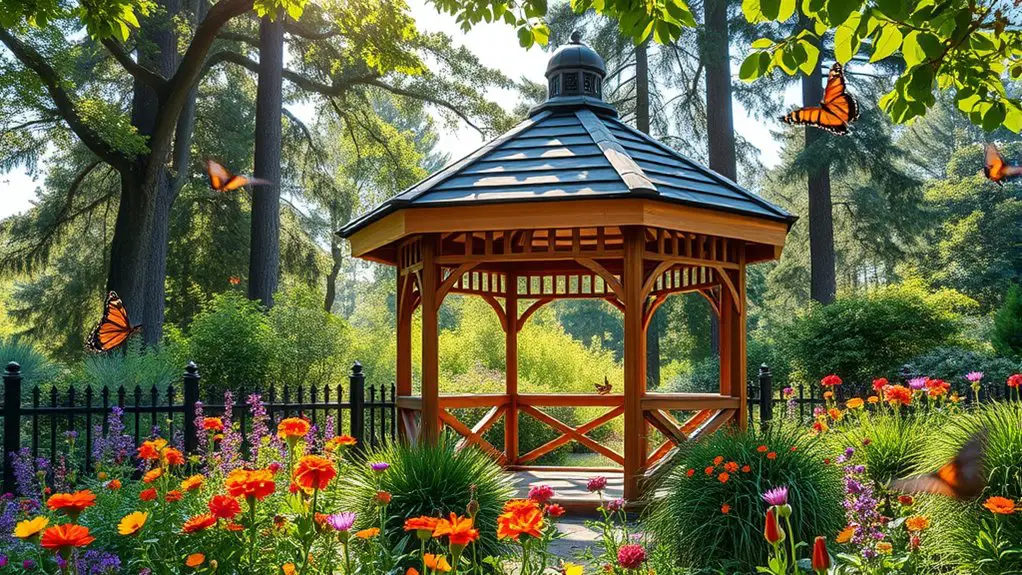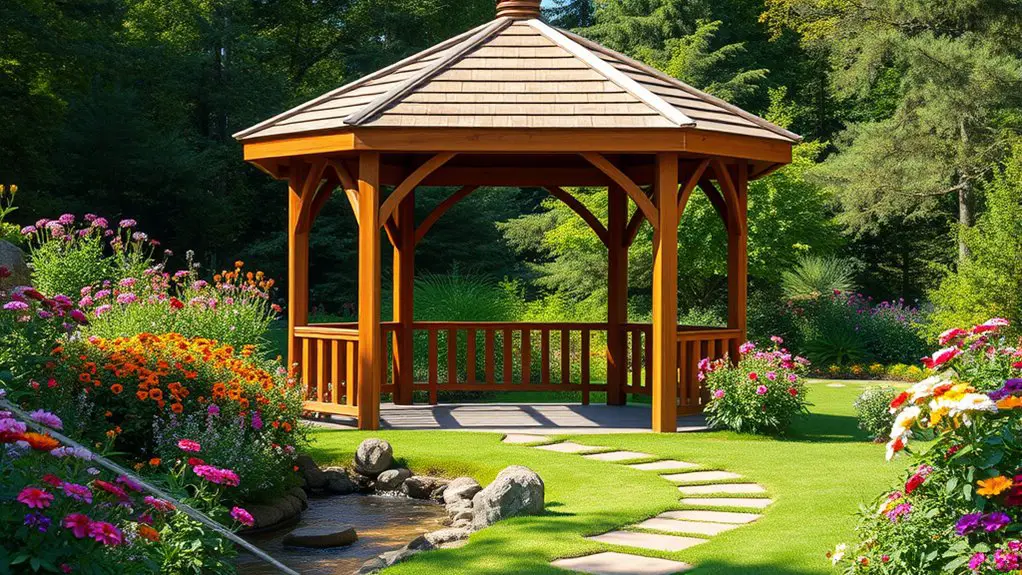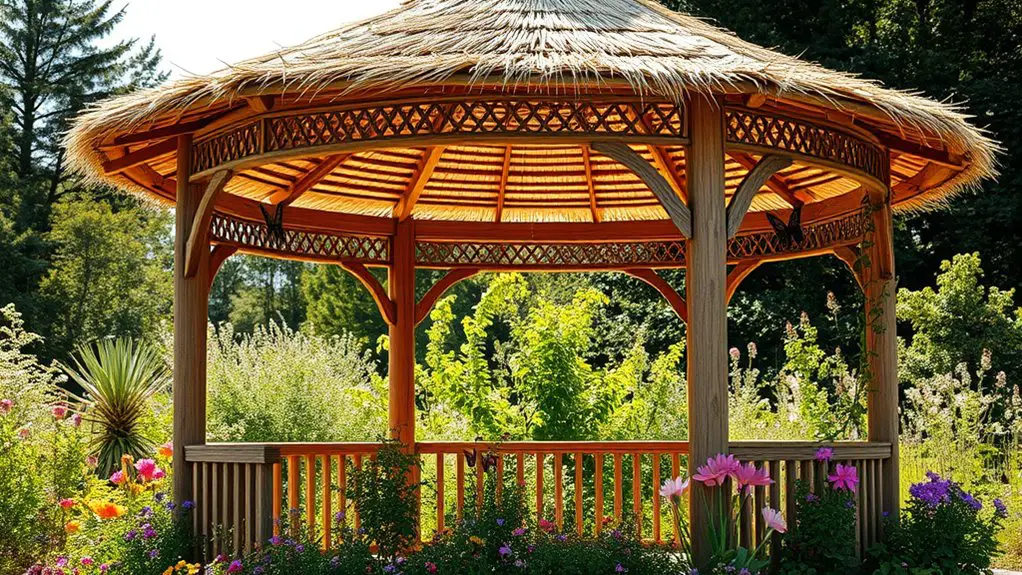To design a gazebo for butterfly watching, choose a sunny, sheltered spot with at least six hours of sunlight daily. Surround it with native plants like milkweed and coneflowers, and consider adding small ponds or fountains for water features. Create comfortable seating that faces active butterfly areas, ensuring you have space to move. Use local materials like stone and sustainable wood for a natural look. Continue exploring these ideas to enhance your butterfly-friendly oasis even further.
Choosing the Right Location for Your Gazebo

When you’re choosing the right location for your gazebo, it’s essential to contemplate the natural habitat of butterflies, as they thrive in sunny, sheltered areas surrounded by flowers. Look for a spot that enjoys ample sunlight exposure, ideally with at least six hours of direct sunlight daily. This will create a warm microclimate that attracts these delicate creatures.
Additionally, consider wind protection. Position your gazebo near natural barriers like hedges or trees, which can shield it from gusty winds that deter butterflies. A well-placed gazebo not only enhances your viewing experience but also contributes to a vibrant ecosystem. Moreover, it’s important to consider sun and shade exposure, as a balance will help sustain the butterfly population while providing comfort for your outdoor activities.
Observe the area’s existing flora; the more diverse the plant life, the better your chances of attracting butterflies. By thoughtfully selecting your gazebo’s location, you’ll create a sanctuary where you can revel in the beauty of fluttering wings while feeling a sense of freedom in nature’s embrace.
Selecting Butterfly-Friendly Plants
To attract butterflies to your gazebo, you’ll want to select a variety of flowering plants that provide both nectar and habitat. Start with native plant selection, as these species are naturally adapted to your local ecosystem, ensuring a harmonious environment. Consider planting milkweed, which is essential for monarchs, and coneflowers, which bloom throughout summer, offering a steady nectar source.
Incorporate seasonal blooms to create a colorful tapestry that lasts from spring through fall. Think about adding asters for late-season butterflies and phlox for vibrant spring displays. Group your plants in clusters to create a more inviting space for butterflies, encouraging them to flit and dance around your gazebo. Additionally, utilizing climbing plants can enhance the greenery and create a more inviting environment for these pollinators.
Don’t forget to leave some areas wild—native grasses and shrubs can provide shelter. With careful selection and thoughtful arrangement, you’ll cultivate a butterfly haven that celebrates nature’s beauty and freedom.
Incorporating Water Features

While butterflies are often drawn to vibrant blooms, incorporating water features into your gazebo design can greatly enhance their attraction. Consider various water feature types, like small ponds, fountains, or birdbaths. Each offers unique benefits—fountains, for instance, create soothing sound effects that can mask external noise, making your space feel more serene and inviting.
Ponds can serve as reflective pools, attracting butterflies while providing a habitat for aquatic life. When designing, think about placement; a fountain near your flower beds will not only catch butterflies’ attention but also draw you into their dance. The gentle splashing of water can create a tranquil atmosphere, encouraging you to linger longer in this butterfly haven. Additionally, planting flowers that attract pollinators can further enhance the experience, creating a vibrant ecosystem around your gazebo.
Designing for Comfort and Observation
Creating a comfortable viewing area is essential for maximizing your butterfly-watching experience, as it allows you to immerse yourself in nature without distraction. Thoughtfully designed seating arrangements and well-placed observation points can enhance your enjoyment.
Consider the following table to optimize your gazebo layout:
| Seating Arrangement | Observation Points |
|---|---|
| Benches | Elevated platforms |
| Lounge chairs | Overlook areas |
| Cushioned seats | Flower beds nearby |
Position your seating to face the most active areas, allowing you to observe the butterflies without straining your neck. Make sure you have enough space between seats so you can move freely, adjusting your position as needed. Think about adding soft cushions or blankets for extra comfort. Additionally, incorporating comfortable seating options will ensure that your space remains inviting for long periods of observation. With these elements in place, you’ll create a serene space that invites you to sit back, relax, and watch the beauty of nature unfold.
Enhancing the Gazebo With Natural Materials

When you incorporate natural materials into your gazebo design, you not only enhance its aesthetic appeal but also create a harmonious connection with the surrounding environment. Using local stone for the foundation or decorative elements grounds your gazebo in the landscape, giving it a sense of permanence. Choose sustainable wood for the structure; it’s not just eco-friendly but also adds warmth and character. The grain patterns and colors of reclaimed timber can tell a story of their own, inviting a sense of nostalgia.
Think about integrating climbing plants or vines around the structure to blur the lines between the gazebo and nature, creating a serene space for butterfly watching. You might even consider a green roof, allowing for biodiversity and sheltering those delicate creatures. By carefully selecting these materials, you’ll craft a gazebo that feels alive and invites freedom, both for you and the butterflies fluttering nearby. Additionally, choosing naturally resistant wood can enhance the durability of the structure while harmonizing with the natural surroundings.
Frequently Asked Questions
What Materials Are Best for a Butterfly Gazebo?
For your gazebo structure, consider durable wood or metal. Add decorative elements like latticework or screens to enhance aesthetics while providing shelter. These choices invite butterflies and create a serene space for observation and relaxation.
How Can I Attract Specific Butterfly Species?
To attract specific butterfly species, plant their preferred nectar sources and host plants. Incorporate butterfly feeders filled with sugar water or fruit, creating a vibrant oasis that draws them in, offering both sustenance and shelter.
What Time of Year Is Best for Butterfly Watching?
The best time for butterfly watching’s during spring migration and summer blooms. You’ll witness vibrant activity as butterflies emerge, seeking nectar. Embrace the freedom of nature’s dance, capturing fleeting moments of beauty and transformation in your surroundings.
How Do I Maintain Butterfly-Friendly Plants?
Did you know that native plants can boost butterfly populations by over 60%? To maintain butterfly-friendly plants, focus on native plant selection and guarantee seasonal maintenance, like pruning and watering, to keep your garden thriving.
Can I Use Pesticides Around My Gazebo?
You shouldn’t use pesticides around your gazebo, as they can harm butterflies. Instead, consider pesticide alternatives like neem oil or diatomaceous earth for organic gardening, ensuring a safe haven for these delicate creatures to thrive.

